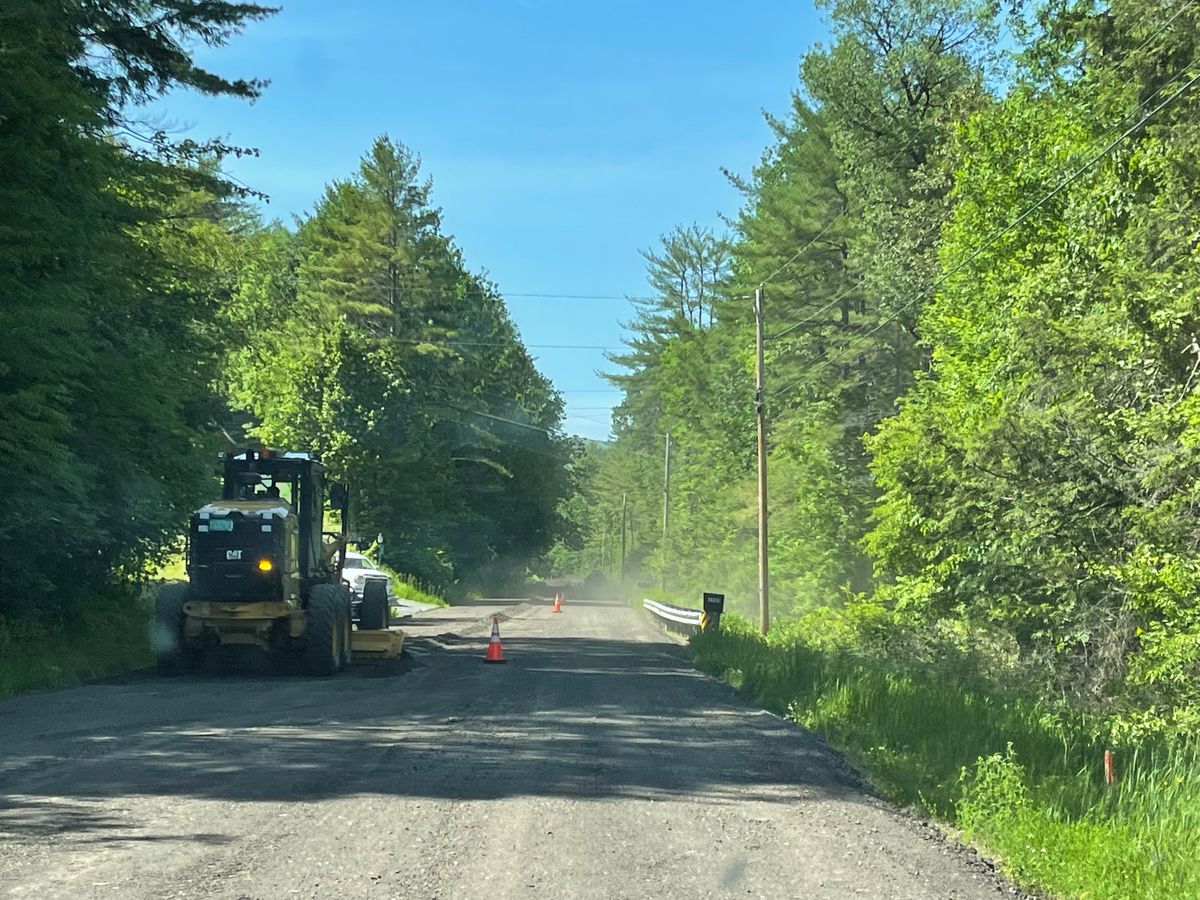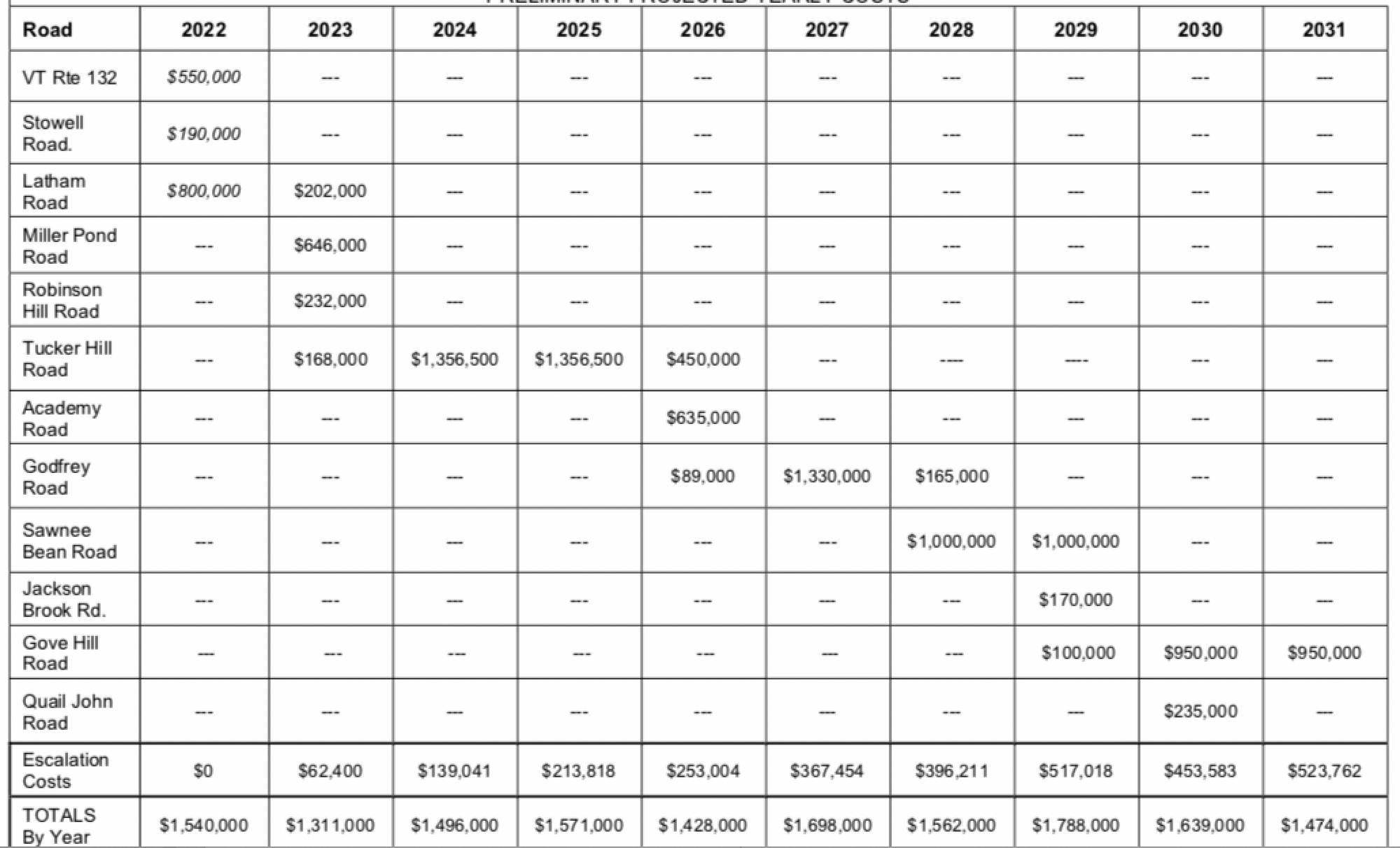Two roads diverged in a wood
Is road repair prohibitively expensive, or a question of priorities?

One must only traverse Tucker Hill Rd or ascend the paved portion of Sawnee Bean Rd to recognize Thetford’s need for maintenance and repair work on its paved arteries. However, with Li Shen’s reporting that the near future might hold little in terms of substantial road work, it raises the question: does it have to be this way?
A former Selectboard Chair from more than a decade past once remarked that the Town had an intentional strategy of allowing the condition of Route 132 to decline to such an extent that the state would be forced to take over responsibility for its repair. The state never did. Instead, the flooding of July 2017 washed out substantial sections of this important connector. It was only an emergency line of credit from the Federal Highway Administration – on which Thetford paid tens of thousands of dollars in interest – that saw the commencement of any repairs.
It was that same flood that saw funds diverted from a long-overdue repair to Latham Rd. The Town used every available penny to repair washed-out roads in 2017, including diverting once-in-a-lifetime logging revenue from town lands, money that was otherwise destined for the Town Lands Maintenance Fund which covers public land management, conservation, and invasive species control (this fund was replenished in 2020).
The Town is now saddled with a $4 million bond for the long overdue work needed on Route 132 – the bond payments represent a roughly 11% increase in the total DPW budget. It is also now looking at another roughly $1 million expense to repair Latham Rd, including re-repairing sections that have degraded since work began roughly 5 years ago.
Despite all this, the 2022 budget codified multiple decisions that have crippled the Town’s ability to respond to unusual weather events, such as flooding or the worst mud season in decades, as well as to adequately plan for future road maintenance and repair needs. For example, the DPW Fund ended 2021 with a surplus and a leftover balance (including surpluses from previous years) of over $400,000. However, $50,000 was used to “buy down” the tax rate — $50,000 that could have been diverted to the Paving Fund. State recommendations point towards maintaining a healthy highway fund balance of between 12-15% of total operating expenses. Even with the $50,000 loss, the DPW Fund balance currently hovers above 28% of total expenses. Roughly $200,000 could have been added to the Paving Fund at the end of 2021 from previous year surplus while maintaining a healthy DPW Fund balance, but it wasn’t.
Further, DPW Contract Services (budget line item 200‐5110‐25.00) was reduced in 2022 from $60,000 to $35,000, a decrease of over 40%. This is precisely the line item that would be used to pay for contracted help above and beyond what the Town's road crew could manage themselves, such as hiring Northwoods Excavating to assist with road repairs during the present exceptional mud season. The impact of reducing this budget line item in the context of this year’s mud season will result in a smaller DPW surplus, or even a deficit, strategically reducing the Town’s ability to invest in the Town’s Paving Fund using previous year surplus at the end of this current fiscal year.
Winter Maintenance Supplies (budget line item 200‐5110‐35.00) saw a $20,000 reduction in 2022, or almost 14%. While it’s true that the road crew has been using less sand and salt year over year due to the implementation of better practices — down from a high actual expense of $202,776 in 2019 — it only takes one warm winter with daytime rains and nighttime freezing to drive the Town’s sand/salt usage through the roof. The current line item has been reduced $40,000 in the past two years, again eating into a potential surplus or leading to a deficit.
Unusual events aside — such as an extreme mud season, summer flooding, or unusually icy winters — these few key decisions represent a lost opportunity to the tune of a quarter million dollars that could have been available to bolster a long-term capital paving plan. And that would have been just business as usual; it wouldn’t have represented any new tax levy. Instead, conscious decisions were made to collapse the road budget in favor of other priorities.
The Town could have continued to fully fund the DPW, leverage surplus for paving, and still have seen a tax rate decrease. How? By keeping a police force of two full-time officers and by working with a third party to assist in the management of Treasure Island. The cost savings from these two measures would be greater than what has been subtracted from the DPW, meaning the tax rate could have been lower than what was put forward at Town Meeting. Instead, both the police and Treasure Island budgets grew. Yet with long-term, pre-pandemic trends of decreasing police call volume and an active Lake Fairlee community that cares deeply for the shoreline and Treasure Island, neither of these cost-saving propositions would have been that far-fetched.
If you think it’s not too late – the Town could still not hire a third officer, or it could still find a management partner for Treasure Island – you may be surprised to learn that this ship has already sailed for 2022. Even if the aforementioned were to manifest, the resulting budget surpluses would exist in the General Fund, not the DPW Fund, and monies cannot be moved, per state statute, between those two discrete funds. In other words, a budget surplus in the General Fund cannot help the Town fund road repairs. If, however, the reduction were budgeted for out of the General Fund balance sheet, that reduction would directly offset any tax implications on the DPW Fund balance sheet, such as funding for Contract Services or Winter Road Supplies. The 2022 budget, of course, has already been passed.
Having already cut critical line items and being over budget due to mud season-related repairs, it will be a financial risk to leverage any portion of the remaining DPW Fund balance for Latham or any other road. It’s a risk Town Hall might be forced to take, or delay repairs to Latham Road for another year.
The risk is increased by another decision made: a roughly $40,000 unbudgeted expense to hire an engineering firm to develop a five-year road plan. They came back with a 10-year plan. The firm acknowledged that the plan’s relevancy will degrade each year as costs change unpredictably:
A 5.0% escalation rate (per year) was applied for each year that the road work is projected beyond 2022. The current economic climate makes estimating the actual escalation rate that can be expected from year to year extremely difficult, given the recent history of inflation and the costs of construction over the past 3-years, as compared to inflation prior to the COVID pandemic.All estimates should be considered preliminary, including estimate engineering costs.
The estimate over the 10 years comes out to $15,706,000 for an average of $1,570,600 per year starting in 2022. This would represent a total municipal tax rate increase of over 50%, more than doubling the current DPW budget (a municipal property tax bill of $2,000 would increase to $3,000). These are just the paved roads. It does not include gravel roads. It also does not include the tax rate increases related to the Route 132 bond payments (the final step increase will be in 2023).

The two roads mentioned at the beginning of this article, Tucker Hill Rd and Sawnee Bean Rd, are estimated to cost roughly $3.3 million and $2 million respectively.
At the Town's current rate of funding – $125,000 contributed to the Paving Fund per year – the 10-year road plan would take over 125 years to fund. Unfortunately, the cost of the 10-year plan, being unbudgeted, will have yet another impact on the DPW Fund balance, decreasing possible surplus or contributing to a deficit in fiscal year 2022. This further increases the risk of using that balance for actual repair work. Perhaps worst of all, the plan was solicited in spite of Town Hall knowing that Latham Rd was already a priority; they didn’t need a costly engineering study to confirm it. In fact, the Town already had preliminary engineering work completed for Latham Rd.
By the time the Town is in the position to perform substantial road work, costs will need to be re-estimated. And depending on the time that's elapsed, road conditions may need to be re-evaluated and prioritized. $40,000 that could've gone towards repairs this year will instead be sitting on a shelf collecting dust.
These considerations represent choices, but it was not the choice of Town Hall to put the highest financial priority on actual road repair. It seems two roads did indeed diverge in a wood, and one was severely less well maintained. Let’s hope there are absolutely zero unusual weather events in our future, because the Town will likely be forced to turn again to a costly line of credit.
